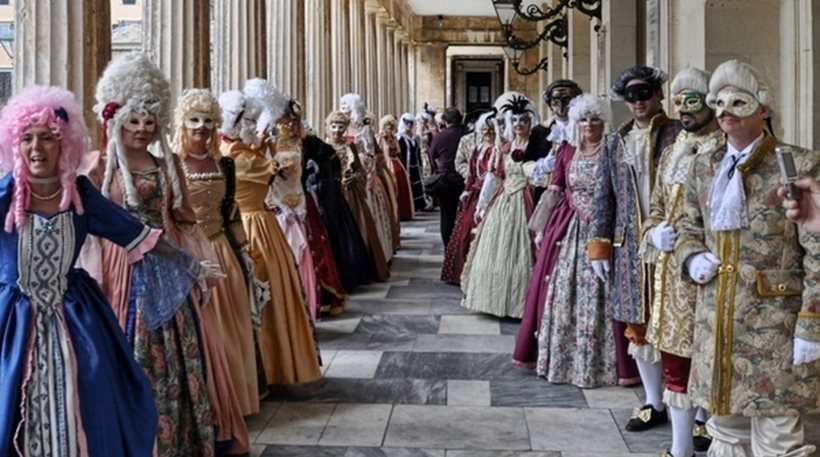The Carnival of Corfu Island.
Carnival
The roots of the Corfiot Carnival are lost in the Dionysiac worship of ancient Greece. The Carnival of Corfu was revived during the time of the Venetian occupation of the island and through a course of more than 450 years, reaches our times, regenerated each year
The Latin word CARNEVALE is probably derived from the Latin phrase carnem levare = to disappear the meat, consequently abstain from meat.
The Carnival in the Country Site

According to Carolos Klimis, until a few decades ago, in the highlands of Corfu, the carnival custom of phallus and the jinx, (Dionysiac symbols), was taking place during the last Sunday of the carnival (Tyrofagos). Even today in the mountainous villages of Episkepsis, Nymphes and Klimatia a unique tradition is conducted – the “Dance of the Priests” singing the song “Doxa na”, a custom that combines paganistic worship and Christian religion.
Carnival in the City

The rulers and noblemen, of foreign or local origin, were participating at the festivities, which at the beginning consisted of indoor happenings. In several houses balls were held with masks and european dresses, with a nostalgia for the cosmopolitan atmosphere and the splendidness of the Metropolis. Gradually, imitating the Venetian way of life, club for the Nobles was organized in Corfu, together with card-playing casinos and a theater, where the comedies of the Venetian aristocrat Carlo Goldoni were performed and soon were assimilated, became tradition and were loved by the Corfiots.
Intense card playing was taking place during the carnival period. Four casinos existed in the city, the casino for the Venetian Noblemen, that for the Corfiot Noblemen, the one for the army-officers and the high-rank clerks and the casino for the officers of the navy. The casinos had rooms for conversation and tables for card-playing -they were playing tresette, briscola, paseta and pharaoh. In one of these the famous Giacomo Casanova participated, “in Corfu? I was spending all my time in the coffee-shop playing rabidly pharaoh”, he wrote.
Polychromy, cheerfulness, ‘brio’, high-spirit and most of all public participation were the elements that characterized the Carnival of Corfu, which, in combination with the masked-balls and the revel atmosphere in the streets and the alleyways of the city, made Corfu look like Venice, where the revel and the amusement lasted for months and had their own particular color.
The growth of the opera in Corfu had its contribution to the Corfiot Carnival. The transformation of the club of the Nobles to theater in 1720 by the name “Nobile Teatro di San Giacomo” and the calling of Italian groups that performed comedies, ‘opera buffa’ but also prose, lasted the whole of the winter period until the last Sunday of the Carnival. This tradition continued in the 20th century, after the construction of the Municipal Theater.
Masked balls (named Cavalchine) were held in the Theater during the Carnival period. At the beginning the tickets were expensive in order to provide a financial support to the actors, but this was abolished by the last Proveditor Carolo Aurelio Widman, so that everybody could afford to go. Ladies with fancy outfits and well-dressed masquerades attended the balls from the rented theater boxes, exchanging glances, colorful serpentines and love letters, while during the intervals they were exchanging visits. Many balls were held and the last one could not go further than the 12:00 at mid-night of the last Sunday, when all the masks were dropped. The archives tell as about six-day balls, two nights with signatures (veglione) and four common nights with masks (cavalchine). The balls were a way of life and never stopped, not even during the Russo-Turkish siege (November 1798-February 1799).
Later the after-midnight dances were transferred to several privet ballrooms in the city. In large dancing-floors special teacher were teaching ‘Cuadrilias’ and ‘lancie’, which were the highlight of the night. Except that in the Municipal Theater the dances of the ‘Old Philharmonic’, of ‘Gymnastiriou’ and that of ‘Rolina’, have remained unforgettable ever since.
The Nobles and the well-off were masqueraded in dominos and harlequins, wearing masks (mouzeta) and constructing kiosks in Spianada Sq., decorated with greens and flowers, contesting on the best kiosk decoration and throwing each other violets and serpentines, and watering the passers-by with “pompets’ of watered perfume. The last Sunday of the Carnival everybody was with masks on the Liston, either walking or on coach for the ‘Will’ and the cremation of King-Carnival at 12 at mid-night.
Giostres
At sometime during the 16th century, the Venetians, imitating the Metropolis, established the ‘Giostre’ in Corfu during the carnival period.

With the revival of the chivalric spirit during the Renaissance period and the reconstitution of the Chivalric Orders, many jousts were held, not in the battlefields, but in the city-centers and in many cases inside the palace-complexes. In Venice the “Giostra” prevailed, which exhibited the war-virtues of the individual, something that the Renaissance greatly favored.
Two ‘Giostre” were set the prize during the Carnival period in Corfu. The Noble youth took part in the first, which was held in the Spianada Sq., and the soldiers in the other, which was held inside the Old Fortress.
Since the mid-18th century the two types that the Noble youth was contesting, were moved in Strada Larga (Moustoxydi Str.) In the first, named Giostra all’anello, the mounted contestant had to pass his lance through a ring, and in the other, named Giostra alla quintana or saracino, the mounted contestant had to hit as many times he could a puppet with a face of a saracen. The master of the games was the “MAESTRO DI CAMPO”, who was chosen from the Council of the Nobles. The representatives of the Venetian and the Corfiot authorities watched the games from the Midei house, which probably is the Ricci estate with the large balcony and the Venetian mourioni. Special judges, the ‘giostra judges’ were standing on an elaborate kiosk at the end of the run and decided the winner. They awarded the prize (palio) to the winner who in turn offered a banquet in his house at the same night. A similar atmosphere existed at the soldier’s ‘giostra’ inside the Old Fortress.
The ‘giostre’ carried on during the 19th century with the same ordered way as in the time of the Venetians. Even then they were colorful and romantic events if we judge from a proclamation of a ‘giostra’ in 1834: “Eros to the ladies, Honor to the brave, Glory to the valiant”.
Carnival of the Recent Times
With the outbreak of the Second World War the Corfiot Carnival, with the intense popular participation, became inactive but in 1955 a group of romantic Corfiots, the Manesis and Kourkoumelis families, took the initiative and decided the reorganization of the festivities.
They tried with love and desire for the old times and managed to bring happiness and laughter to the Corfiots once again, who responded with the organization of balls and parades. In 1962 the “Organization of Corfiot Festivities and Happenings” (OKEE) was established, who supported the initiative of the previously mentioned team. Hundreds ofmasquerades and many floats welcomed at the old port the ‘live’ King Sior-Carnival (an exclusive characteristic of the Corfiot Carnival) who gave laughter and ‘decorated’ everyone with his ‘comments’-“petegoletsa” (gossip).
During the years of dictatorship (1967-1974) this fiesta became once more inactive and in 1975 with the establishment of the “Organization of Corfiot Festivities”, the Corfiot Carnival revived again. Since 1981 the “Organization of Corfiot Activities”, with the aid and assistance of the Municipality of Corfu, is the main organization responsible for the revival of the Corfiot Carnival and so far has succeeded, with the cooperation of many cultural clubs and associations, to organize many splendi
Petegoletsa
One of the new elements of the 
The Corfiot Carnival with many significant qualitative differences from the other Greek Carnivals has the ambition to continue a 450 years old tradition. The “Organization of Corfiot Activities” tries to exhibit the identity of the Corfiot Carnival, which is based on the particularity of the Heptanisian Civilisation, which successfully fused together the systematic Western way of thinking with the local element and the Greek character of the place.









